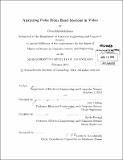

M.I.T. theses are protected by copyright. They may be viewed from this source for any purpose, but reproduction or distribution in any format is prohibited without written permission. See provided URL for inquiries about permission. http://dspace.mit.edu/handle/1721.1/7582
We extract heart rate and beat lengths from videos by measuring subtle head oscillations that accompany the cardiac cycle. Our method tracks features on the head, temporally filters their trajectories and performs principal component analysis (PCA) to decompose the trajectories into a set of ID component motions. It then chooses the component that is most periodic as the pulse signal. Finally, we identify peaks of the chosen signal, which correspond to heartbeats. When evaluated on 18 subjects our approach reported heart rates nearly identical to an electrocardiogram (ECG) device for all subjects and obtained similar beat length distributions for 17. In addition we obtained pulse rate from videos of the back of the head and of sleeping newborns. Initial findings also show that our method can measure heart rate from body parts other than the head and can measure respiration rate by selecting a different frequency band. Finally, we present visualization techniques such as motion magnification for subjective analysis of body motions
Thesis: S.M. in Computer Science and Engineering, Massachusetts Institute of Technology, Department of Electrical Engineering and Computer Science, 2014.